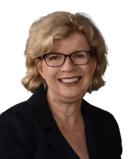Midlife
Images of Mid-life and Older Women Affect Our Self Image
Who are the female role models who show us it's OK to be getting older?
Posted December 7, 2012
I was struggling with the topic of “images of mid-life and older women” for a while and then it happened: I saw the photo that pulled it all together. The Huffington Post’s photo of Hillary Clinton and Meryl Streep, both blonde and all-dressed up, leaning in cheek to cheek to snap an iPhone picture. Wow! More magazine’s Facebook page shared this photo and noted, “Don’t they look wonderful and every bit their age (63 and 65, respectively)?” That’s what I’ve been thinking about. I’ve been looking for women of a certain age who appear to be treading a middle path—not letting themselves go, but yes, letting themselves get older and not ashamed to show it. And lovely Meryl Streep and our Secretary of State fit the bill.
Funny, but an image of older womanhood that I keep coming back to is one of the earliest in my experience: the character of Aunt Bea from The Andy Griffith Show, a TV show I watched in daily reruns in the early 1960s of my childhood. Aunt Bea was old. You could tell because she wore flowered dresses, orthopedic shoes, and a little veiled hat for Sunday church. She was stout in an older lady way, a way I’m starting to see in my own profile—thick waist, full bosom. She (actress Francis Bouvier) had a rather high, girlish older lady voice. Yet Aunt Bea was still healthy and strong. She had spirit. She commanded the kitchen and cared for Andy and Opie. We could tell that she was needed and respected by her family and by others in that warm and somewhat wacky community of Mayberry, North Carolina.
Unlike so many women today, Aunt Bea was not embarrassed to look and act her age. Oh, I know, we probably won’t be trying to recreate Aunt Bea's look! She was a product of an era when single older women were supposed to be relatively sexless and did not have the advantages we have today—especially what we know now about the importance of exercise and nutrition and the fact that sexuality is an important aspect of life to people at all ages.
It seems to me it is a difficult time, in some ways, to be a mid-life woman who is looking ahead to later life. Sure, we Baby Boomers have a lot of company around our own chronological ages. We’re certainly not alone. But do we have female role models who show us it’s OK to be getting older? Other than Meryl Streep, that rare Hollywood actress who is not afraid to look approximately her age, who are the middle-aged and younger-old women in the public eye who seem to accept their age with panache and without disguising themselves? When asking myself this question, I naturally turned to thoughts of the women we see on television and in movies.
From my own anecdotal observations, I did not see too many good examples. Then I read a recent Sunday New York Times Magazine article (11/18/12) that confirmed my own thoughts. Carina Chocano, writing about women’s age and the myth of women being “in their prime” at ridiculously early ages, cites Martha M. Lauzen, who spoke in a documentary (Miss Representation by Jennifer Siebel Newsom) about the actresses we see on television: “…women in their teens, 20s and 30s are 39 percent of the population, yet are 71 percent of the women on TV. Women 40 and older are 47 percent of the population, yet are 26 percent of the women on TV.”
So it’s not just me. There are fewer “older” or even “mid-life” women on television than in real life. Female stars of many sitcoms and the myriad detective, law, and police procedurals tend to be ingenues, young women playing doctors or lawyers or improbably young parents of teenagers. And as these women age into their 40s or beyond, many are trying to “pass” as younger than they are.
These professional actresses tend to have good bone structure to begin with and maintain good physical condition (though sometimes they are thin to a fault). Constant work on their hair, skin, teeth and makeup keep them ready for the camera. Additional procedures smooth fine lines, fill in wrinkles, and lift sagging chins. Along with lots of exercise, technologically sophisticated undergarments and sometimes breast lifts or tummy tucks help to mold these women’s aging bodies to fit our cultural expectations of beauty: youthful, reproductive readiness in the trim hourglass figure with full breasts and slim waist and legs.
The 40s for most women constitute perimenopause and by 50 or so we are moving beyond our reproductive years. But these facts of life don’t seem to apply to many women celebrities. So a sleek and buff Jennifer Aniston, Courteney Cox, or Julie Bowen are what the early 40s looks like on TV and in the movies these days, and Marie Osmond, Valerie Bertinelli, Kyra Sedgwick or Dana Delaney are what 50ish looks like. They are thin, high-heeled, and dressed in body-conscious styles with long flowing hair. These TV women may not be realistic role models for many of us. And they might not even be the way we want to look at similar ages.
I can think of a few women celebrities in their late 50s or early 60s who are aging gracefully, especially comedians and character actresses such as Lily Tomlin and Jane Alexander. And representing the oldest generation of women on TV, Cloris Leachman and Betty White are still going strong. British actresses apparently excel at aging a bit more naturally. Helen Mirren, obviously blessed with good genetics and good natural attributes, does not seem to be in age denial in her early 60s. Maggie Smith has aged naturally and distinctively, playing strong characters in many movies, including the Harry Potter series. And Dame Judi Dench shows her age proudly and beautifully in film roles ranging from the sublime to the James Bond franchise, where she portrays the very much in charge spy boss, “M.”
One of the reasons I decided to blog about mid-life and aging was because I see all around me evidence of “age disavowal”—examples of insidious ageism in various forms, particularly for women. If we try to pretend we aren’t aging, we are engaging in this to some extent. If we believe that there are only two possible stages for women: young, sexy ingenue and frail wizened gray-haired lady, we will find it harder to make a smooth transition and find a comfortable place for ourselves in the middle.
Along the way to becoming older women, I would like women in their 40s and 50s to respect ourselves; to be healthy and active, but not to feel ashamed because we are no longer at the peak of sexual attractiveness. There are quite a few years before arriving at the ages of Aunt Bea, Maggie Smith, or Betty White. How do we present ourselves and feel about ourselves along the way? Let’s celebrate our own versions of Meryl Streep’s sweet humor, Hillary Clinton’s intelligence, and Judi Dench’s capacity for resolve. Though she was past mid-life, I’d like to translate some of the Aunt Bea’s sense of self as a woman of her chronological age into our lives as contemporary mid-life women, but maybe without the flowered dresses and veiled hats.




